Optimizing spiking neural networks¶
Almost all deep learning methods are based on gradient descent, which means that the network being optimized needs to be differentiable. Deep neural networks are usually built using rectified linear or sigmoid neurons, as these are differentiable nonlinearities. However, in biological neural modelling we often want to use spiking neurons, which are not differentiable. So the challenge is how to apply deep learning methods to spiking neural networks.
A method for accomplishing this is presented in Hunsberger and Eliasmith (2016). The basic idea is to use a differentiable approximation of the spiking neurons during the training process, and the actual spiking neurons during inference. NengoDL will perform these transformations automatically if the user tries to optimize a model containing a spiking neuron model that has an equivalent, differentiable rate-based implementation. In this example we will use these techniques to develop a network to classify handwritten digits (MNIST) in a spiking convolutional network.
[1]:
%matplotlib inline
import gzip
import pickle
from urllib.request import urlretrieve
import zipfile
import nengo
import tensorflow as tf
import numpy as np
import matplotlib.pyplot as plt
import nengo_dl
/home/travis/virtualenv/python3.6.3/lib/python3.6/site-packages/tensorflow/python/framework/dtypes.py:516: FutureWarning: Passing (type, 1) or '1type' as a synonym of type is deprecated; in a future version of numpy, it will be understood as (type, (1,)) / '(1,)type'.
_np_qint8 = np.dtype([("qint8", np.int8, 1)])
/home/travis/virtualenv/python3.6.3/lib/python3.6/site-packages/tensorflow/python/framework/dtypes.py:517: FutureWarning: Passing (type, 1) or '1type' as a synonym of type is deprecated; in a future version of numpy, it will be understood as (type, (1,)) / '(1,)type'.
_np_quint8 = np.dtype([("quint8", np.uint8, 1)])
/home/travis/virtualenv/python3.6.3/lib/python3.6/site-packages/tensorflow/python/framework/dtypes.py:518: FutureWarning: Passing (type, 1) or '1type' as a synonym of type is deprecated; in a future version of numpy, it will be understood as (type, (1,)) / '(1,)type'.
_np_qint16 = np.dtype([("qint16", np.int16, 1)])
/home/travis/virtualenv/python3.6.3/lib/python3.6/site-packages/tensorflow/python/framework/dtypes.py:519: FutureWarning: Passing (type, 1) or '1type' as a synonym of type is deprecated; in a future version of numpy, it will be understood as (type, (1,)) / '(1,)type'.
_np_quint16 = np.dtype([("quint16", np.uint16, 1)])
/home/travis/virtualenv/python3.6.3/lib/python3.6/site-packages/tensorflow/python/framework/dtypes.py:520: FutureWarning: Passing (type, 1) or '1type' as a synonym of type is deprecated; in a future version of numpy, it will be understood as (type, (1,)) / '(1,)type'.
_np_qint32 = np.dtype([("qint32", np.int32, 1)])
/home/travis/virtualenv/python3.6.3/lib/python3.6/site-packages/tensorflow/python/framework/dtypes.py:525: FutureWarning: Passing (type, 1) or '1type' as a synonym of type is deprecated; in a future version of numpy, it will be understood as (type, (1,)) / '(1,)type'.
np_resource = np.dtype([("resource", np.ubyte, 1)])
WARNING:tensorflow:From /home/travis/build/nengo/nengo-dl/nengo_dl/compat.py:26: The name tf.random_uniform is deprecated. Please use tf.random.uniform instead.
WARNING:tensorflow:From /home/travis/build/nengo/nengo-dl/nengo_dl/__init__.py:38: The name tf.logging.set_verbosity is deprecated. Please use tf.compat.v1.logging.set_verbosity instead.
WARNING:tensorflow:From /home/travis/build/nengo/nengo-dl/nengo_dl/__init__.py:38: The name tf.logging.WARN is deprecated. Please use tf.compat.v1.logging.WARN instead.
WARNING:tensorflow:From /home/travis/build/nengo/nengo-dl/nengo_dl/__init__.py:43: The name tf.disable_v2_behavior is deprecated. Please use tf.compat.v1.disable_v2_behavior instead.
WARNING:tensorflow:From /home/travis/virtualenv/python3.6.3/lib/python3.6/site-packages/tensorflow/python/compat/v2_compat.py:61: disable_resource_variables (from tensorflow.python.ops.variable_scope) is deprecated and will be removed in a future version.
Instructions for updating:
non-resource variables are not supported in the long term
/home/travis/virtualenv/python3.6.3/lib/python3.6/site-packages/tensorboard/compat/tensorflow_stub/dtypes.py:541: FutureWarning: Passing (type, 1) or '1type' as a synonym of type is deprecated; in a future version of numpy, it will be understood as (type, (1,)) / '(1,)type'.
_np_qint8 = np.dtype([("qint8", np.int8, 1)])
/home/travis/virtualenv/python3.6.3/lib/python3.6/site-packages/tensorboard/compat/tensorflow_stub/dtypes.py:542: FutureWarning: Passing (type, 1) or '1type' as a synonym of type is deprecated; in a future version of numpy, it will be understood as (type, (1,)) / '(1,)type'.
_np_quint8 = np.dtype([("quint8", np.uint8, 1)])
/home/travis/virtualenv/python3.6.3/lib/python3.6/site-packages/tensorboard/compat/tensorflow_stub/dtypes.py:543: FutureWarning: Passing (type, 1) or '1type' as a synonym of type is deprecated; in a future version of numpy, it will be understood as (type, (1,)) / '(1,)type'.
_np_qint16 = np.dtype([("qint16", np.int16, 1)])
/home/travis/virtualenv/python3.6.3/lib/python3.6/site-packages/tensorboard/compat/tensorflow_stub/dtypes.py:544: FutureWarning: Passing (type, 1) or '1type' as a synonym of type is deprecated; in a future version of numpy, it will be understood as (type, (1,)) / '(1,)type'.
_np_quint16 = np.dtype([("quint16", np.uint16, 1)])
/home/travis/virtualenv/python3.6.3/lib/python3.6/site-packages/tensorboard/compat/tensorflow_stub/dtypes.py:545: FutureWarning: Passing (type, 1) or '1type' as a synonym of type is deprecated; in a future version of numpy, it will be understood as (type, (1,)) / '(1,)type'.
_np_qint32 = np.dtype([("qint32", np.int32, 1)])
/home/travis/virtualenv/python3.6.3/lib/python3.6/site-packages/tensorboard/compat/tensorflow_stub/dtypes.py:550: FutureWarning: Passing (type, 1) or '1type' as a synonym of type is deprecated; in a future version of numpy, it will be understood as (type, (1,)) / '(1,)type'.
np_resource = np.dtype([("resource", np.ubyte, 1)])
First we’ll load the training data, the MNIST digits/labels.
[2]:
urlretrieve("http://deeplearning.net/data/mnist/mnist.pkl.gz",
"mnist.pkl.gz")
with gzip.open("mnist.pkl.gz") as f:
train_data, _, test_data = pickle.load(f, encoding="latin1")
train_data = list(train_data)
test_data = list(test_data)
for data in (train_data, test_data):
one_hot = np.zeros((data[0].shape[0], 10))
one_hot[np.arange(data[0].shape[0]), data[1]] = 1
data[1] = one_hot
for i in range(3):
plt.figure()
plt.imshow(np.reshape(train_data[0][i], (28, 28)),
cmap="gray")
plt.axis('off')
plt.title(str(np.argmax(train_data[1][i])));
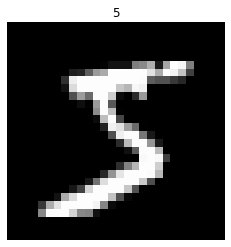
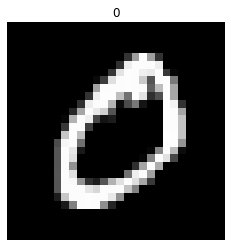
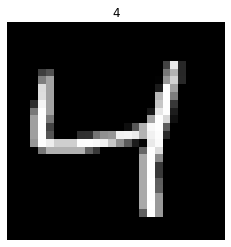
We will use TensorNodes to construct the network, as they allow us to easily include features such as convolutional connections. To make things even easier, we’ll use nengo_dl.tensor_layer. This is a utility function for constructing TensorNodes that mimics the layer-based syntax of many deep learning packages (e.g. tf.layers). The full documentation for this function can be
found here.
tensor_layer is used to build a sequence of layers, where each layer takes the output of the previous layer and applies some transformation to it. So when we build a tensor_layer we pass it the input to the layer, the transformation we want to apply (expressed as a function that accepts a tf.Tensor as input and produces a tf.Tensor as output), and any arguments to that transformation function. tensor_layer also has optional transform and synapse parameters that set
those respective values on the Connection from the previous layer to the one being constructed.
Normally all signals in a Nengo model are (batched) vectors. However, certain layer functions, such as convolutional layers, may expect a different shape for their inputs. If the shape_in argument is specified for a tensor_layer then the inputs to the layer will automatically be reshaped to the given shape. Note that this shape does not include the batch dimension on the first axis, as that will be automatically set by the simulation.
tensor_layer can also be passed a Nengo NeuronType, instead of a Tensor function. In this case tensor_layer will construct an Ensemble implementing the given neuron nonlinearity (the rest of the arguments work the same).
Note that tensor_layer is just a syntactic wrapper for constructing TensorNodes or Ensembles; anything we build with a tensor_layer we could instead construct directly using those underlying components. tensor_layer just simplifies the construction of this common layer-based pattern.
[3]:
with nengo.Network() as net:
# set some default parameters for the neurons that will make
# the training progress more smoothly
net.config[nengo.Ensemble].max_rates = nengo.dists.Choice([100])
net.config[nengo.Ensemble].intercepts = nengo.dists.Choice([0])
neuron_type = nengo.LIF(amplitude=0.01)
# we'll make all the nengo objects in the network
# non-trainable. we could train them if we wanted, but they don't
# add any representational power. note that this doesn't affect
# the internal components of tensornodes, which will always be
# trainable or non-trainable depending on the code written in
# the tensornode.
nengo_dl.configure_settings(trainable=False)
# the input node that will be used to feed in input images
inp = nengo.Node([0] * 28 * 28)
# add the first convolutional layer
x = nengo_dl.tensor_layer(
inp, tf.layers.conv2d, shape_in=(28, 28, 1), filters=32,
kernel_size=3)
# apply the neural nonlinearity
x = nengo_dl.tensor_layer(x, neuron_type)
# add another convolutional layer
x = nengo_dl.tensor_layer(
x, tf.layers.conv2d, shape_in=(26, 26, 32),
filters=64, kernel_size=3)
x = nengo_dl.tensor_layer(x, neuron_type)
# add a pooling layer
x = nengo_dl.tensor_layer(
x, tf.layers.average_pooling2d, shape_in=(24, 24, 64),
pool_size=2, strides=2)
# another convolutional layer
x = nengo_dl.tensor_layer(
x, tf.layers.conv2d, shape_in=(12, 12, 64),
filters=128, kernel_size=3)
x = nengo_dl.tensor_layer(x, neuron_type)
# another pooling layer
x = nengo_dl.tensor_layer(
x, tf.layers.average_pooling2d, shape_in=(10, 10, 128),
pool_size=2, strides=2)
# linear readout
x = nengo_dl.tensor_layer(x, tf.layers.dense, units=10)
# we'll create two different output probes, one with a filter
# (for when we're simulating the network over time and
# accumulating spikes), and one without (for when we're
# training the network using a rate-based approximation)
out_p = nengo.Probe(x)
out_p_filt = nengo.Probe(x, synapse=0.1)
WARNING:tensorflow:From /home/travis/build/nengo/nengo-dl/nengo_dl/tensor_node.py:366: conv2d (from tensorflow.python.layers.convolutional) is deprecated and will be removed in a future version.
Instructions for updating:
Use `tf.keras.layers.Conv2D` instead.
WARNING:tensorflow:From /home/travis/virtualenv/python3.6.3/lib/python3.6/site-packages/tensorflow/python/ops/init_ops.py:1251: calling VarianceScaling.__init__ (from tensorflow.python.ops.init_ops) with dtype is deprecated and will be removed in a future version.
Instructions for updating:
Call initializer instance with the dtype argument instead of passing it to the constructor
WARNING:tensorflow:Entity <bound method Conv.call of <tensorflow.python.layers.convolutional.Conv2D object at 0x7fd8baafdf60>> could not be transformed and will be executed as-is. Please report this to the AutgoGraph team. When filing the bug, set the verbosity to 10 (on Linux, `export AUTOGRAPH_VERBOSITY=10`) and attach the full output. Cause: converting <bound method Conv.call of <tensorflow.python.layers.convolutional.Conv2D object at 0x7fd8baafdf60>>: AssertionError: Bad argument number for Name: 3, expecting 4
WARNING: Entity <bound method Conv.call of <tensorflow.python.layers.convolutional.Conv2D object at 0x7fd8baafdf60>> could not be transformed and will be executed as-is. Please report this to the AutgoGraph team. When filing the bug, set the verbosity to 10 (on Linux, `export AUTOGRAPH_VERBOSITY=10`) and attach the full output. Cause: converting <bound method Conv.call of <tensorflow.python.layers.convolutional.Conv2D object at 0x7fd8baafdf60>>: AssertionError: Bad argument number for Name: 3, expecting 4
WARNING:tensorflow:Entity <bound method Conv.call of <tensorflow.python.layers.convolutional.Conv2D object at 0x7fd8baa37978>> could not be transformed and will be executed as-is. Please report this to the AutgoGraph team. When filing the bug, set the verbosity to 10 (on Linux, `export AUTOGRAPH_VERBOSITY=10`) and attach the full output. Cause: converting <bound method Conv.call of <tensorflow.python.layers.convolutional.Conv2D object at 0x7fd8baa37978>>: AssertionError: Bad argument number for Name: 3, expecting 4
WARNING: Entity <bound method Conv.call of <tensorflow.python.layers.convolutional.Conv2D object at 0x7fd8baa37978>> could not be transformed and will be executed as-is. Please report this to the AutgoGraph team. When filing the bug, set the verbosity to 10 (on Linux, `export AUTOGRAPH_VERBOSITY=10`) and attach the full output. Cause: converting <bound method Conv.call of <tensorflow.python.layers.convolutional.Conv2D object at 0x7fd8baa37978>>: AssertionError: Bad argument number for Name: 3, expecting 4
WARNING:tensorflow:From /home/travis/build/nengo/nengo-dl/nengo_dl/tensor_node.py:366: average_pooling2d (from tensorflow.python.layers.pooling) is deprecated and will be removed in a future version.
Instructions for updating:
Use keras.layers.AveragePooling2D instead.
WARNING:tensorflow:Entity <bound method Pooling2D.call of <tensorflow.python.layers.pooling.AveragePooling2D object at 0x7fd8ba9e6c88>> could not be transformed and will be executed as-is. Please report this to the AutgoGraph team. When filing the bug, set the verbosity to 10 (on Linux, `export AUTOGRAPH_VERBOSITY=10`) and attach the full output. Cause: converting <bound method Pooling2D.call of <tensorflow.python.layers.pooling.AveragePooling2D object at 0x7fd8ba9e6c88>>: AssertionError: Bad argument number for Name: 3, expecting 4
WARNING: Entity <bound method Pooling2D.call of <tensorflow.python.layers.pooling.AveragePooling2D object at 0x7fd8ba9e6c88>> could not be transformed and will be executed as-is. Please report this to the AutgoGraph team. When filing the bug, set the verbosity to 10 (on Linux, `export AUTOGRAPH_VERBOSITY=10`) and attach the full output. Cause: converting <bound method Pooling2D.call of <tensorflow.python.layers.pooling.AveragePooling2D object at 0x7fd8ba9e6c88>>: AssertionError: Bad argument number for Name: 3, expecting 4
WARNING:tensorflow:Entity <bound method Conv.call of <tensorflow.python.layers.convolutional.Conv2D object at 0x7fd8baafda58>> could not be transformed and will be executed as-is. Please report this to the AutgoGraph team. When filing the bug, set the verbosity to 10 (on Linux, `export AUTOGRAPH_VERBOSITY=10`) and attach the full output. Cause: converting <bound method Conv.call of <tensorflow.python.layers.convolutional.Conv2D object at 0x7fd8baafda58>>: AssertionError: Bad argument number for Name: 3, expecting 4
WARNING: Entity <bound method Conv.call of <tensorflow.python.layers.convolutional.Conv2D object at 0x7fd8baafda58>> could not be transformed and will be executed as-is. Please report this to the AutgoGraph team. When filing the bug, set the verbosity to 10 (on Linux, `export AUTOGRAPH_VERBOSITY=10`) and attach the full output. Cause: converting <bound method Conv.call of <tensorflow.python.layers.convolutional.Conv2D object at 0x7fd8baafda58>>: AssertionError: Bad argument number for Name: 3, expecting 4
WARNING:tensorflow:Entity <bound method Pooling2D.call of <tensorflow.python.layers.pooling.AveragePooling2D object at 0x7fd8baa542e8>> could not be transformed and will be executed as-is. Please report this to the AutgoGraph team. When filing the bug, set the verbosity to 10 (on Linux, `export AUTOGRAPH_VERBOSITY=10`) and attach the full output. Cause: converting <bound method Pooling2D.call of <tensorflow.python.layers.pooling.AveragePooling2D object at 0x7fd8baa542e8>>: AssertionError: Bad argument number for Name: 3, expecting 4
WARNING: Entity <bound method Pooling2D.call of <tensorflow.python.layers.pooling.AveragePooling2D object at 0x7fd8baa542e8>> could not be transformed and will be executed as-is. Please report this to the AutgoGraph team. When filing the bug, set the verbosity to 10 (on Linux, `export AUTOGRAPH_VERBOSITY=10`) and attach the full output. Cause: converting <bound method Pooling2D.call of <tensorflow.python.layers.pooling.AveragePooling2D object at 0x7fd8baa542e8>>: AssertionError: Bad argument number for Name: 3, expecting 4
WARNING:tensorflow:From /home/travis/build/nengo/nengo-dl/nengo_dl/tensor_node.py:366: dense (from tensorflow.python.layers.core) is deprecated and will be removed in a future version.
Instructions for updating:
Use keras.layers.dense instead.
WARNING:tensorflow:Entity <bound method Dense.call of <tensorflow.python.layers.core.Dense object at 0x7fd8baa9fd30>> could not be transformed and will be executed as-is. Please report this to the AutgoGraph team. When filing the bug, set the verbosity to 10 (on Linux, `export AUTOGRAPH_VERBOSITY=10`) and attach the full output. Cause: converting <bound method Dense.call of <tensorflow.python.layers.core.Dense object at 0x7fd8baa9fd30>>: AssertionError: Bad argument number for Name: 3, expecting 4
WARNING: Entity <bound method Dense.call of <tensorflow.python.layers.core.Dense object at 0x7fd8baa9fd30>> could not be transformed and will be executed as-is. Please report this to the AutgoGraph team. When filing the bug, set the verbosity to 10 (on Linux, `export AUTOGRAPH_VERBOSITY=10`) and attach the full output. Cause: converting <bound method Dense.call of <tensorflow.python.layers.core.Dense object at 0x7fd8baa9fd30>>: AssertionError: Bad argument number for Name: 3, expecting 4
Next we can construct a Simulator for that network.
[4]:
minibatch_size = 200
sim = nengo_dl.Simulator(net, minibatch_size=minibatch_size)
Build finished in 0:00:00
| # Optimizing graph: creating signals | 0:00:00
/home/travis/build/nengo/nengo-dl/nengo_dl/simulator.py:102: UserWarning: No GPU support detected. It is recommended that you install tensorflow-gpu (`pip install tensorflow-gpu`).
"No GPU support detected. It is recommended that you "
Optimization finished in 0:00:01
WARNING:tensorflow:From /home/travis/build/nengo/nengo-dl/nengo_dl/simulator.py:160: The name tf.set_random_seed is deprecated. Please use tf.compat.v1.set_random_seed instead.
WARNING:tensorflow:From /home/travis/build/nengo/nengo-dl/nengo_dl/simulator.py:160: The name tf.set_random_seed is deprecated. Please use tf.compat.v1.set_random_seed instead.
|# Constructing graph | 0:00:00WARNING:tensorflow:From /home/travis/build/nengo/nengo-dl/nengo_dl/tensor_graph.py:200: The name tf.placeholder is deprecated. Please use tf.compat.v1.placeholder instead.
WARNING:tensorflow:From /home/travis/build/nengo/nengo-dl/nengo_dl/tensor_graph.py:200: The name tf.placeholder is deprecated. Please use tf.compat.v1.placeholder instead.
WARNING:tensorflow:From /home/travis/build/nengo/nengo-dl/nengo_dl/tensor_graph.py:205: The name tf.train.get_or_create_global_step is deprecated. Please use tf.compat.v1.train.get_or_create_global_step instead.
WARNING:tensorflow:From /home/travis/build/nengo/nengo-dl/nengo_dl/tensor_graph.py:205: The name tf.train.get_or_create_global_step is deprecated. Please use tf.compat.v1.train.get_or_create_global_step instead.
| Constructing graph: creating base arrays (0%) | ETA: --:--:--WARNING:tensorflow:From /home/travis/build/nengo/nengo-dl/nengo_dl/tensor_graph.py:234: The name tf.variable_scope is deprecated. Please use tf.compat.v1.variable_scope instead.
WARNING:tensorflow:From /home/travis/build/nengo/nengo-dl/nengo_dl/tensor_graph.py:234: The name tf.variable_scope is deprecated. Please use tf.compat.v1.variable_scope instead.
|###### Constructing graph: build stage (9%) | ETA: 0:00:03WARNING:tensorflow:Entity <bound method Conv.call of <tensorflow.python.layers.convolutional.Conv2D object at 0x7fd8b94d5a90>> could not be transformed and will be executed as-is. Please report this to the AutgoGraph team. When filing the bug, set the verbosity to 10 (on Linux, `export AUTOGRAPH_VERBOSITY=10`) and attach the full output. Cause: converting <bound method Conv.call of <tensorflow.python.layers.convolutional.Conv2D object at 0x7fd8b94d5a90>>: AssertionError: Bad argument number for Name: 3, expecting 4
WARNING:tensorflow:Entity <bound method Conv.call of <tensorflow.python.layers.convolutional.Conv2D object at 0x7fd8b94d5a90>> could not be transformed and will be executed as-is. Please report this to the AutgoGraph team. When filing the bug, set the verbosity to 10 (on Linux, `export AUTOGRAPH_VERBOSITY=10`) and attach the full output. Cause: converting <bound method Conv.call of <tensorflow.python.layers.convolutional.Conv2D object at 0x7fd8b94d5a90>>: AssertionError: Bad argument number for Name: 3, expecting 4
WARNING: Entity <bound method Conv.call of <tensorflow.python.layers.convolutional.Conv2D object at 0x7fd8b94d5a90>> could not be transformed and will be executed as-is. Please report this to the AutgoGraph team. When filing the bug, set the verbosity to 10 (on Linux, `export AUTOGRAPH_VERBOSITY=10`) and attach the full output. Cause: converting <bound method Conv.call of <tensorflow.python.layers.convolutional.Conv2D object at 0x7fd8b94d5a90>>: AssertionError: Bad argument number for Name: 3, expecting 4
|############ Constructing graph: build stage (19%) | ETA: 0:00:01WARNING:tensorflow:From /home/travis/build/nengo/nengo-dl/nengo_dl/neuron_builders.py:348: add_dispatch_support.<locals>.wrapper (from tensorflow.python.ops.array_ops) is deprecated and will be removed in a future version.
Instructions for updating:
Use tf.where in 2.0, which has the same broadcast rule as np.where
WARNING:tensorflow:From /home/travis/build/nengo/nengo-dl/nengo_dl/neuron_builders.py:348: add_dispatch_support.<locals>.wrapper (from tensorflow.python.ops.array_ops) is deprecated and will be removed in a future version.
Instructions for updating:
Use tf.where in 2.0, which has the same broadcast rule as np.where
|##############Constructing graph: build stage (29%) | ETA: 0:00:02
WARNING:tensorflow:Entity <bound method Conv.call of <tensorflow.python.layers.convolutional.Conv2D object at 0x7fd8b9399e10>> could not be transformed and will be executed as-is. Please report this to the AutgoGraph team. When filing the bug, set the verbosity to 10 (on Linux, `export AUTOGRAPH_VERBOSITY=10`) and attach the full output. Cause: converting <bound method Conv.call of <tensorflow.python.layers.convolutional.Conv2D object at 0x7fd8b9399e10>>: AssertionError: Bad argument number for Name: 3, expecting 4
WARNING: Entity <bound method Conv.call of <tensorflow.python.layers.convolutional.Conv2D object at 0x7fd8b9399e10>> could not be transformed and will be executed as-is. Please report this to the AutgoGraph team. When filing the bug, set the verbosity to 10 (on Linux, `export AUTOGRAPH_VERBOSITY=10`) and attach the full output. Cause: converting <bound method Conv.call of <tensorflow.python.layers.convolutional.Conv2D object at 0x7fd8b9399e10>>: AssertionError: Bad argument number for Name: 3, expecting 4
|##############Constructing graph: build stage (48%) | ETA: 0:00:01WARNING:tensorflow:Entity <bound method Pooling2D.call of <tensorflow.python.layers.pooling.AveragePooling2D object at 0x7fd8d930ba20>> could not be transformed and will be executed as-is. Please report this to the AutgoGraph team. When filing the bug, set the verbosity to 10 (on Linux, `export AUTOGRAPH_VERBOSITY=10`) and attach the full output. Cause: converting <bound method Pooling2D.call of <tensorflow.python.layers.pooling.AveragePooling2D object at 0x7fd8d930ba20>>: AssertionError: Bad argument number for Name: 3, expecting 4
WARNING:tensorflow:Entity <bound method Pooling2D.call of <tensorflow.python.layers.pooling.AveragePooling2D object at 0x7fd8d930ba20>> could not be transformed and will be executed as-is. Please report this to the AutgoGraph team. When filing the bug, set the verbosity to 10 (on Linux, `export AUTOGRAPH_VERBOSITY=10`) and attach the full output. Cause: converting <bound method Pooling2D.call of <tensorflow.python.layers.pooling.AveragePooling2D object at 0x7fd8d930ba20>>: AssertionError: Bad argument number for Name: 3, expecting 4
WARNING: Entity <bound method Pooling2D.call of <tensorflow.python.layers.pooling.AveragePooling2D object at 0x7fd8d930ba20>> could not be transformed and will be executed as-is. Please report this to the AutgoGraph team. When filing the bug, set the verbosity to 10 (on Linux, `export AUTOGRAPH_VERBOSITY=10`) and attach the full output. Cause: converting <bound method Pooling2D.call of <tensorflow.python.layers.pooling.AveragePooling2D object at 0x7fd8d930ba20>>: AssertionError: Bad argument number for Name: 3, expecting 4
|##############Constructing graph: build stage (58%) | ETA: 0:00:00WARNING:tensorflow:Entity <bound method Conv.call of <tensorflow.python.layers.convolutional.Conv2D object at 0x7fd8baf95b70>> could not be transformed and will be executed as-is. Please report this to the AutgoGraph team. When filing the bug, set the verbosity to 10 (on Linux, `export AUTOGRAPH_VERBOSITY=10`) and attach the full output. Cause: converting <bound method Conv.call of <tensorflow.python.layers.convolutional.Conv2D object at 0x7fd8baf95b70>>: AssertionError: Bad argument number for Name: 3, expecting 4
WARNING:tensorflow:Entity <bound method Conv.call of <tensorflow.python.layers.convolutional.Conv2D object at 0x7fd8baf95b70>> could not be transformed and will be executed as-is. Please report this to the AutgoGraph team. When filing the bug, set the verbosity to 10 (on Linux, `export AUTOGRAPH_VERBOSITY=10`) and attach the full output. Cause: converting <bound method Conv.call of <tensorflow.python.layers.convolutional.Conv2D object at 0x7fd8baf95b70>>: AssertionError: Bad argument number for Name: 3, expecting 4
WARNING: Entity <bound method Conv.call of <tensorflow.python.layers.convolutional.Conv2D object at 0x7fd8baf95b70>> could not be transformed and will be executed as-is. Please report this to the AutgoGraph team. When filing the bug, set the verbosity to 10 (on Linux, `export AUTOGRAPH_VERBOSITY=10`) and attach the full output. Cause: converting <bound method Conv.call of <tensorflow.python.layers.convolutional.Conv2D object at 0x7fd8baf95b70>>: AssertionError: Bad argument number for Name: 3, expecting 4
|##############Constructing graph: build stage (77%) | ETA: 0:00:00WARNING:tensorflow:Entity <bound method Pooling2D.call of <tensorflow.python.layers.pooling.AveragePooling2D object at 0x7fd8b9215ef0>> could not be transformed and will be executed as-is. Please report this to the AutgoGraph team. When filing the bug, set the verbosity to 10 (on Linux, `export AUTOGRAPH_VERBOSITY=10`) and attach the full output. Cause: converting <bound method Pooling2D.call of <tensorflow.python.layers.pooling.AveragePooling2D object at 0x7fd8b9215ef0>>: AssertionError: Bad argument number for Name: 3, expecting 4
WARNING:tensorflow:Entity <bound method Pooling2D.call of <tensorflow.python.layers.pooling.AveragePooling2D object at 0x7fd8b9215ef0>> could not be transformed and will be executed as-is. Please report this to the AutgoGraph team. When filing the bug, set the verbosity to 10 (on Linux, `export AUTOGRAPH_VERBOSITY=10`) and attach the full output. Cause: converting <bound method Pooling2D.call of <tensorflow.python.layers.pooling.AveragePooling2D object at 0x7fd8b9215ef0>>: AssertionError: Bad argument number for Name: 3, expecting 4
WARNING: Entity <bound method Pooling2D.call of <tensorflow.python.layers.pooling.AveragePooling2D object at 0x7fd8b9215ef0>> could not be transformed and will be executed as-is. Please report this to the AutgoGraph team. When filing the bug, set the verbosity to 10 (on Linux, `export AUTOGRAPH_VERBOSITY=10`) and attach the full output. Cause: converting <bound method Pooling2D.call of <tensorflow.python.layers.pooling.AveragePooling2D object at 0x7fd8b9215ef0>>: AssertionError: Bad argument number for Name: 3, expecting 4
|##############Constructing graph: build stage (87%)#### | ETA: 0:00:00WARNING:tensorflow:Entity <bound method Dense.call of <tensorflow.python.layers.core.Dense object at 0x7fd8b91b9240>> could not be transformed and will be executed as-is. Please report this to the AutgoGraph team. When filing the bug, set the verbosity to 10 (on Linux, `export AUTOGRAPH_VERBOSITY=10`) and attach the full output. Cause: converting <bound method Dense.call of <tensorflow.python.layers.core.Dense object at 0x7fd8b91b9240>>: AssertionError: Bad argument number for Name: 3, expecting 4
WARNING:tensorflow:Entity <bound method Dense.call of <tensorflow.python.layers.core.Dense object at 0x7fd8b91b9240>> could not be transformed and will be executed as-is. Please report this to the AutgoGraph team. When filing the bug, set the verbosity to 10 (on Linux, `export AUTOGRAPH_VERBOSITY=10`) and attach the full output. Cause: converting <bound method Dense.call of <tensorflow.python.layers.core.Dense object at 0x7fd8b91b9240>>: AssertionError: Bad argument number for Name: 3, expecting 4
WARNING: Entity <bound method Dense.call of <tensorflow.python.layers.core.Dense object at 0x7fd8b91b9240>> could not be transformed and will be executed as-is. Please report this to the AutgoGraph team. When filing the bug, set the verbosity to 10 (on Linux, `export AUTOGRAPH_VERBOSITY=10`) and attach the full output. Cause: converting <bound method Dense.call of <tensorflow.python.layers.core.Dense object at 0x7fd8b91b9240>>: AssertionError: Bad argument number for Name: 3, expecting 4
Construction finished in 0:00:02
Now we need to train this network to classify MNIST digits. First we load our input images and target labels.
We need to incorporate time into this data, since Nengo models (and spiking neural networks in general) always run over time. When training the model we’ll be using a rate-based approximation, so we can run that for a single timestep. But when testing the model we’ll be using the spiking neuron models, so we need to run the model for multiple timesteps in order to collect the spike data over time.
[5]:
# add the single timestep to the training data
train_data = {inp: train_data[0][:, None, :],
out_p: train_data[1][:, None, :]}
# when testing our network with spiking neurons we will need to run it
# over time, so we repeat the input/target data for a number of
# timesteps. we're also going to reduce the number of test images, just
# to speed up this example.
n_steps = 30
test_data = {
inp: np.tile(test_data[0][:minibatch_size*2, None, :],
(1, n_steps, 1)),
out_p_filt: np.tile(test_data[1][:minibatch_size*2, None, :],
(1, n_steps, 1))}
Next we need to define our objective (error) function. Because this is a classification task we’ll use categorical cross entropy, instead of the default mean squared error.
[6]:
def objective(outputs, targets):
return tf.nn.softmax_cross_entropy_with_logits_v2(
logits=outputs, labels=targets)
The last thing we need to specify is the optimizer. For this example we’ll use RMSProp.
[7]:
opt = tf.train.RMSPropOptimizer(learning_rate=0.001)
In order to quantify the network’s performance we will also define a classification error function (the percentage of test images classified incorrectly). We could use the cross entropy objective, but classification error is easier to interpret. Note that we use the output from the network on the final timestep (as we are simulating the network over time).
[8]:
def classification_error(outputs, targets):
return 100 * tf.reduce_mean(
tf.cast(tf.not_equal(tf.argmax(outputs[:, -1], axis=-1),
tf.argmax(targets[:, -1], axis=-1)),
tf.float32))
print("error before training: %.2f%%" % sim.loss(
test_data, {out_p_filt: classification_error}))
| Calculating loss (0%) | ETA: --:--:--WARNING:tensorflow:From /home/travis/build/nengo/nengo-dl/nengo_dl/simulator.py:1071: The name tf.train.Saver is deprecated. Please use tf.compat.v1.train.Saver instead.
WARNING:tensorflow:From /home/travis/build/nengo/nengo-dl/nengo_dl/simulator.py:1071: The name tf.train.Saver is deprecated. Please use tf.compat.v1.train.Saver instead.
|####################Calculating loss (100%)###################| ETA: 00:00:00WARNING:tensorflow:From /home/travis/virtualenv/python3.6.3/lib/python3.6/site-packages/tensorflow/python/training/saver.py:1276: checkpoint_exists (from tensorflow.python.training.checkpoint_management) is deprecated and will be removed in a future version.
Instructions for updating:
Use standard file APIs to check for files with this prefix.
WARNING:tensorflow:From /home/travis/virtualenv/python3.6.3/lib/python3.6/site-packages/tensorflow/python/training/saver.py:1276: checkpoint_exists (from tensorflow.python.training.checkpoint_management) is deprecated and will be removed in a future version.
Instructions for updating:
Use standard file APIs to check for files with this prefix.
Calculation finished in 0:01:22
error before training: 89.75%
Now we are ready to train the network. In order to keep this example relatively quick we are going to download some pretrained weights. However, if you’d like to run the training yourself set do_training=True below.
[9]:
do_training = False
if do_training:
# run training
sim.train(train_data, opt, objective={out_p: objective}, n_epochs=10)
# save the parameters to file
sim.save_params("./mnist_params")
else:
# download pretrained weights
urlretrieve(
"https://drive.google.com/uc?export=download&"
"id=1u9JyNuRxQDUcFgkRnI1qfJVFMdnGRsjI",
"mnist_params.zip")
with zipfile.ZipFile("mnist_params.zip") as f:
f.extractall()
# load parameters
sim.load_params("./mnist_params")
Now we can check the classification error again, with the trained parameters.
[10]:
print("error after training: %.2f%%" % sim.loss(
test_data, {out_p_filt: classification_error}))
Calculation finished in 0:01:14
error after training: 0.75%
We can see that the spiking neural network is achieving ~1% error, which is what we would expect for MNIST. n_steps could be increased to further improve performance, since we would get a more accurate measure of each spiking neuron’s output.
We can also plot some example outputs from the network, to see how it is performing over time.
[11]:
sim.run_steps(n_steps, data={inp: test_data[inp][:minibatch_size]})
for i in range(5):
plt.figure()
plt.subplot(1, 2, 1)
plt.imshow(np.reshape(test_data[inp][i, 0], (28, 28)),
cmap="gray")
plt.axis('off')
plt.subplot(1, 2, 2)
plt.plot(sim.trange(), sim.data[out_p_filt][i])
plt.legend([str(i) for i in range(10)], loc="upper left")
plt.xlabel("time")
Simulation finished in 0:00:38
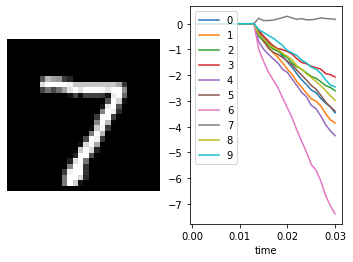
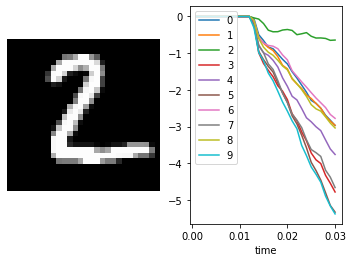
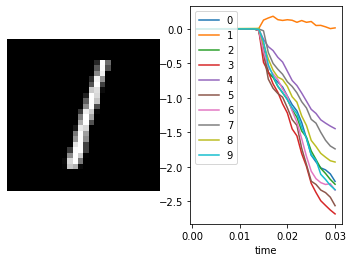
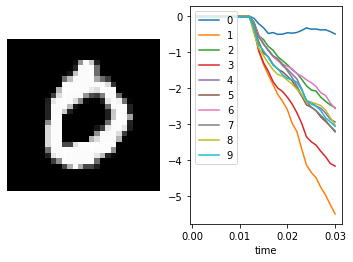
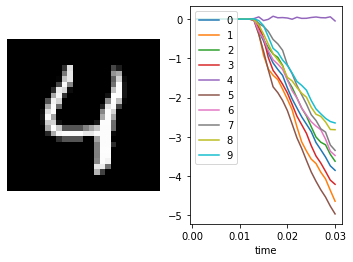
[12]:
sim.close()